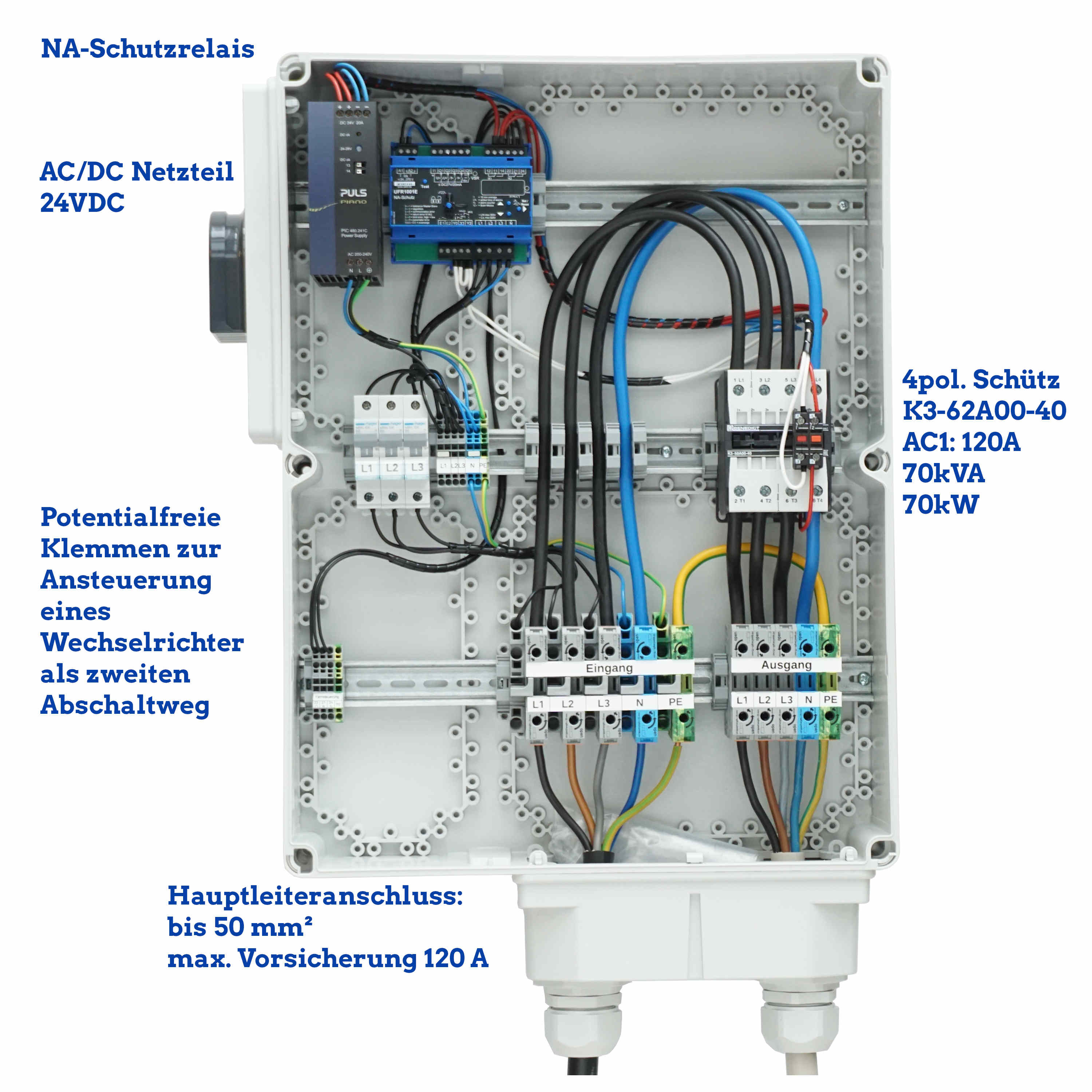Network and Plant Protection: The Key Role of Protection for Solar Energy Efficiency and Safety

AC-Coupling vs. Central Coupling for Solar Systems
According to the application rule VDE-AR-N 4105:2018-11, a network and system protection (NA protection) is required for all power generation systems in Germany with a capacity ranging from 30 kW to 135 kW. This protective device plays a crucial role in the safe integration of solar systems into the power grid, ensuring compliance with specified voltage and frequency tolerances, as well as avoiding islanding.
The NA protection, as per VDE-AR-N 4105, continuously monitors the voltage and frequency of the supply network to ensure they remain within the specified tolerances. In case of deviations, the NA protection securely disconnects the power generation system from the grid within 0.2 seconds. In this context, fault safety means that two independently controlled switching elements are connected in series, so that the function is maintained even if one switch fails.
The obligation to implement NA protection for solar power systems in Germany arises from two main reasons:
- Compliance with voltage and frequency limits in the power grid: The NA protection ensures that the energy generated by the solar system does not exceed the specified limits for voltage and frequency. This is crucial to ensure grid stability and avoid disruptions in the power network.
- Islanding prevention: In the event of maintenance work or network disturbances, the solar system must be quickly and safely disconnected from the grid to ensure the safety of maintenance personnel and prevent the formation of island networks. The NA protection enables rapid shutdown of the system in such situations.
Depending on the size of the solar system, either a central or decentralized NA protection can be employed. Larger systems typically utilize a central NA protection, while smaller systems can employ decentralized protection solutions.
Compliance with the NA protection requirement is of great importance for commercial rooftop photovoltaic systems in Germany. It is essential for solar system operators to install the necessary protective devices in accordance with applicable regulations to ensure the safety of the power grid and compliance with legal requirements.
How a Classic NA Protection Works
The NA protection consists of two main components:
- The network and system protection relay that monitors the power grid.
- The interlocking switch that is controlled by the relay.
The NA protection is installed at the metering point and monitors the voltage and frequency. In case of a fault, two galvanically isolated interlocking switches are disconnected in series (redundant configuration). The switching devices must have a switching capacity equivalent to the rated power of the solar system.
For each switching device, there is a separate output at the monitoring relay, which is independently controlled. The switching devices report their current switching position back to the monitoring relay to ensure the required "fault safety".
For systems with a capacity of 100 kW or more, motor protection switches or mechanical power/last disconnectors are permitted. Smaller systems can also use contactors.
Decentralized NA Protection for Smaller PV Systems
Smaller solar systems are often installed closer to the grid connection point, resulting in short cable distances and relatively low current flow, which leads to negligible voltage drops. Therefore, for smaller PV systems with a capacity below 30 kW or for cogeneration units, the NA protection can also be installed in sub-distributions or integrated into the programmable control of the system, such as the solar inverter.
AC-Coupling vs. Central Coupling Switch
The acquisition and operational costs of NA protection can add up and have a significant impact on the profitability of the system. To ensure compliance with the regulations for switching off inverters, many available products on the market require an expensive external coupling switch. One way to save costs is to replace the central coupling switch with an AC-coupling switch.
An example of this is the Sunny Tripower CORE1 inverter by SMA Solar Technology AG, which ensures the required network and system protection (NA protection) according to VDE-AR-N 4105:2018-11, Chapter 6.4.1, Method C for systems with a capacity of 30 kW to 135 kW through an integrated AC-coupling switch. The AC-coupling switch integrated in the Sunny Tripower CORE1 inverter is tested for proper functioning by the inverter before each connection process. The inverter also checks the switch's switching capability on a daily basis. In case of a malfunction, the error is reported, and the inverter does not connect to the public power grid, even if the central NA protection is active.
Similar to Fronius inverters, the corresponding coupling switches become unnecessary as they are already equipped with suitable relays as a standard feature, allowing the devices to be disconnected within 100 ms. The function can be easily and quickly set up using an app, without the need for additional hardware in the inverter.